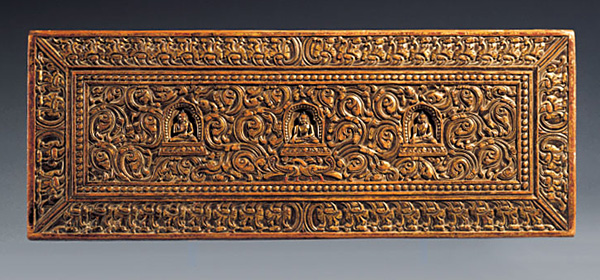|

Tibetan manuscript covers take a profound place in Asian art history. They are an important vehicle for the transmission and development of the Buddhist teachings. Tibetan Buddhism has emerged as one of the most vital and influential school of Buddhism, where its teachers preserved and continued the unbroken lineage of their spiritual, philosophical and literary knowledge. The manuscripts are originally executed with text pages of paper leaves stacked one on top of another, which become fragile with age. The hard-wooden covers above and below are protecting the sacred Buddhist texts. Masterfully carved, gilded and painted in a magnificent way, they reflect their religious importance. The present manuscript cover has the depiction of three cosmic Buddhas who can be distinguished by their mudras. Aksobhya (centre) is the embodiment of Vijnana (consciousness) and holds his right hand in Bhumisparsa mudra (calling the earth to witness); Amoghasiddha (left) is symbolising Samskara (adaptation) and hold his right hand in abhaya mudra (protection and the blessing of fearlessness); and Rathnasambhava (right) is the embodiment of Vedana (sensation), holding his right hand in varada mudra (gesture of charity).
The central panel of the manuscript cover has the depiction of three cosmic Buddhas, (see description above), each of them seated in vajrasana (legs crossed) on a single lotusthrone. They are dressed in a fine sanghati covering their bodies and leaving their right shoulders bare, and are portrayed with elongated ears and an ushnisa on top of their heads, the symbol of their spiritual wisdom. A large nimbus is depicted behind them. Two peacocks are reproduced below the central Buddha's base; the peacock (mayura) is the mount of the cosmic Buddha Amithabha and its feathers (mayurapiccha) are among one of the Buddhist symbols. The movement of the striking foliate motifs is repeated in the outer border. The cover is in addition decorated with lotusleaves and a string of thick pearls bordering the central panel. The reverse is painted in red, gold, yellow and black comprising the depiction of seventy five wheels, each of them symbolising the Buddhist law.
With the introduction of Buddhism into Tibet in the 7th century, Tibetan monks travelled to India and across the Himalaya to study and develop the teachings of the Buddha and began to translating Sanskrit works into their own language. The Tibetan Buddhist canon was assembled during the following centuries, and by the 14th century, hundreds of monasteries were already founded with each of them having their own library. The primary religious inspiration came from the Pala school of art in North-Eastern India and had accordingly an important influence in the artistic development in Tibet. The typical stylistic characteristics of this early central Tibetan manuscript cover are the pronounced foliate motifs in the central panel and in the outer rim, the line of pearls, the large lotus leaves (pala style) of the lotusthrones, the nimbuses with tick pearls, and the typical repeating shape of the lotusflowers. The design of the painting on the reverse is in conformity with pieces dated to the 12th and 13th century.
The present manuscript cover is a classic and wonderful example of an early Tibetan style which still reveals the superiority of the Pala craftsmanship combined with the mythical religious contents . All features are skilfully carved in a pure and confident way, with great lines, natural volumes and fine movements. The cover is imbued with a powerful and consistent rhythm, the Buddhas and birds being positioned delicately in the central panel, and with fine gilding complementing the lively and serene representation. The piece which is both a sculpture and a painting, the exquisite painting at the reverse in red, gold, yellow and black comprising the depiction of seventy five wheels, and suggests strongly the presence of a serene and mystical Buddhist world.
|

